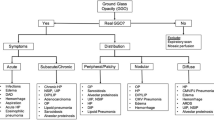Abstract
Patients with polymyositis (PM) or dermatomyositis (DM) frequently show interstitial pneumonia (IP), which is sometimes rapidly progressive or resistant to treatment, thereby significantly affecting the prognosis. The diagnosis and response evaluation of IP are commonly performed qualitatively based on imaging findings, which may cause disagreement among rheumatologists in the evaluation of early lesions and atypical interstitial changes. To determine whether IP could be diagnosed in a quantitative manner during the early stage of PM/DM using a workstation that allows quantitative image processing. Thoracic computed tomography (CT) images of 20 PM/DM patients were reconstructed into a three-dimensional (3D) image using an image processing workstation. The CT values of the constituent voxels were arranged in a histogram of −1000 to +1000 Hounsfield units (HU). The most frequent lung field density was −900 to −801 HU, and relative size was as follows: IP (+) group 0.45 and IP (−) group 0.53. Between −1000 and −701 HU, relative size was not significantly different between the IP (+) group and IP (−) group. Between −700 and −1 HU, the relative size of the lung field was significantly larger in the IP (+) than in the IP (−) group, demonstrating its IP-diagnosing ability. Particularly, within the range from −700 to −301 HU, the macroscopically-assessed ground glass opacity was consistent with the CT value, which, in turn, was closely correlated with KL-6, the pre-existing marker for IP diagnosis. The results of this study may lead to the establishment of quantitative methods of evaluating IP and possible elucidation of the pathogenesis of IP.


Similar content being viewed by others
References
Kocheril SV, Appleton BE, Somers EC et al (2005) Comparison of disease progression and mortality of connective tissue disease-related interstitial lung disease and idiopathic interstitial pneumonia. Arthritis Rheumatol 53:549–557
Kameda H, Nagasawa H, Ogawa H et al (2005) Combination therapy with corticosteroids, cyclosporine a, and intravenous pulse cyclophosphamide for acute/subacute interstitial pneumonia in patients with dermatomyositis. J Rheumatol 32:1719–1726
Matthew JB, David D, James GJ et al (2008) Diagnostic performance of 64-multidetector row coronary computed tomographic angiography for evaluation of coronary artery stenosis in individuals without known coronary artery disease: results from the prospective multicenter ACCRACY (assessment by coronary computed tomographic angiography of individuals undergoing invasive coronary angiography) trial. J Am Coll Cardiol 52:1724–1732
Christopher LS, Dahlia B, Emily S et al (2011) Prognostic value of CT angiography for major adverse cardiac events in patients with acute chest pain from the emergency department: 2 years outcomes of the ROMICAT trial. JACC Cardiovasc Imaging 4:481–491
Johnson CD, Chen MH, Toledano AY et al (2008) Accuracy of CT colonography for detection of large adenomas and cancers. N Engl J Med 359:1207–1217
Kohno N, Kyoizumi S, Awaya Y et al (1989) New serum indicator of interstitial pneumonitis activity: sialylated carbohydrate antigen KL-6. Chest 96:68–73
Hasegawa M, Makita M, Nasuhara Y et al (2009) Relationship between improved airflow limitation and changes in airway calibre induced by inhaled anticholinergic agents in COPD. Thorax 64:332–338
Ikeda K, Awai K, Mori T et al (2007) Differential diagnosis of ground-glass opacity nodules: CT number analysis by three-dimensional computerized quantification. Chest 132:984–990
Camiciottoli G, Orlandi I, Bartoluci M et al (2007) Lung CT densitometry in systemic sclerosis: correlation with lung function, exercise testing, and quality of life. Chest 131:672–681
Douglas WW, Tazelaar HD, Hartman TE et al (2001) Polymyositis-dermatomyositis-associated interstitial lung disease. Am J Respir Crit Care Med 164:1182–1185
Travis WD, Costabel U, Hansell DM et al (2013) An official American thoracic society/European respiratory society statement: update of the international multidisciplinary classification of the idiopathic interstitial pneumonias. Am J Respir Crit Care Med 188:733–748
Millar AB, Denison DM (1990) Vertical gradients of lung density in supine subjects with fibrosing alveolitis or pulmonary emphysema. Thorax 45:602–605
Author information
Authors and Affiliations
Corresponding author
Ethics declarations
Disclosures
None.
Rights and permissions
About this article
Cite this article
– Ozuno, N.T., Akamatsu, H., Takahashi, H. et al. Quantitative diagnosis of connective tissue disease-associated interstitial pneumonia using thoracic computed tomography images. Clin Rheumatol 34, 2113–2118 (2015). https://doi.org/10.1007/s10067-015-3103-y
Received:
Revised:
Accepted:
Published:
Issue Date:
DOI: https://doi.org/10.1007/s10067-015-3103-y




